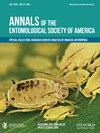Nematodes Versus White Grubs: Long But Challenging Association
IF 3
3区 农林科学
Q1 ENTOMOLOGY
引用次数: 3
Abstract
Abstract Soil as a shared habitat of white grubs and entomopathogenic nematodes (EPNs) is a double-edged sword from the biological control point of view. Soil encompasses a diverse array of EPNs that could be exploited in grub microbial control; on the other hand, soil promotes the natural resistance of grubs to EPNs via the battle between both sides within the soil matrix. White grubs and EPNs have been armed in this battle by a multifaceted range of mechanisms, namely grub structural and physiological barriers, antagonism of grub gut microbiota toward the nematode bacterial symbionts, EPN excreted/secreted proteins, surface coat proteins, ascaroside pheromones produced by EPNs, and evolution of EPN resistance to herbivore self-defense. From the evolutionary point of view, EPN–grub interactions, the most advanced (sophisticated) association among others, could have evolved from other types of associations. Entomophilic nematode (e.g., Pristionchus spp.), the cognate bacterium and scarab associations along with the formation of dauer juveniles, are proof of preadaptation to entomopathogeny in a continual evolution. Here, we delve into the salient features of each component of EPN-white grub–host plant tripartite interactions as well as hints to improved exploitation of EPNs for grub management. Also, evolutionary associations between nematodes and scarabs will be reviewed, in short. Graphical Abstract线虫与白头翁:漫长但充满挑战的联盟
摘要从生物防治的角度来看,土壤作为幼虫和昆虫病原线虫的共同栖息地是一把双刃剑。土壤包含一系列多样的EPN,可用于幼虫微生物控制;另一方面,土壤通过双方在土壤基质内的战斗促进了幼虫对EPN的自然抵抗。在这场战斗中,幼虫和EPN通过一系列多方面的机制武装起来,即幼虫的结构和生理屏障、幼虫肠道微生物群对线虫-细菌共生体的拮抗作用、EPN排泄/分泌的蛋白质、表被蛋白质、EPN产生的蛔虫苷信息素,以及EPN对食草动物自卫的抵抗力的进化。从进化的角度来看,EPN与幼虫的相互作用是最先进(复杂)的关联,可能是从其他类型的关联进化而来的。亲虫线虫(例如Pristionchus spp.),同源细菌和金龟子的结合,以及幼虫的形成,是在持续进化中对昆虫病预适应的证据。在这里,我们深入研究了EPN白幼虫-寄主植物三方相互作用的每个组成部分的显著特征,以及改进利用EPN进行幼虫管理的提示。此外,线虫和圣甲虫之间的进化联系也将被审查,简而言之。图形摘要
本文章由计算机程序翻译,如有差异,请以英文原文为准。
求助全文
约1分钟内获得全文
求助全文
来源期刊
CiteScore
4.90
自引率
0.00%
发文量
25
审稿时长
6-12 weeks
期刊介绍:
The Annals of the Entomological Society of America exists to stimulate interdisciplinary dialogue across the entomological disciplines and to advance cooperative interaction among diverse groups of entomologists. It seeks to attract and publish cutting-edge research, reviews, collections of articles on a common topic of broad interest, and discussion of topics with national or international importance. We especially welcome articles covering developing areas of research, controversial issues or debate, and topics of importance to society. Manuscripts that are primarily reports of new species, methodology, pest management, or the biology of single species generally will be referred to other journals of the ESA. The most important criteria for acceptance are quality of work and breadth of interest to the readership.

 求助内容:
求助内容: 应助结果提醒方式:
应助结果提醒方式:


